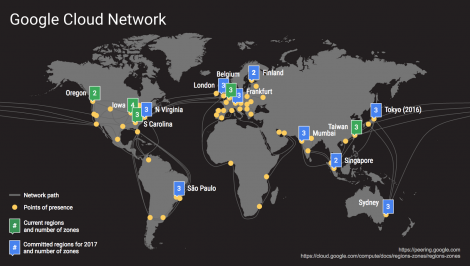The global buildout of cloud data centers by internet giants is marching on. The latest move and countermove in the cloud arms race came from Amazon and Google this week, both companies announcing new locations they are adding to their growing lists of cloud availability regions.
They, as well as Microsoft and IBM, have been investing billions of dollars collectively to expand the global reach of their cloud empires by both building data centers and leasing space from data center providers, such as Digital Realty Trust, Equinix, T-Systems, EdgeConneX, and 21Vianet, among others.
Extending physical infrastructure into new regions reduces latency for customers in those regions, gives users more backup location options, reduces data transport costs (for both users and cloud providers themselves), and helps organizations comply with data-location regulations, wherever they apply.
The next outpost of Amazon’s cloud empire, called Amazon Web Services, will be in the Paris metro. The company announced Thursday plans to bring a French cloud region online next year, following recent announcements of upcoming regions in Ohio, Canada, China, and the UK.
The French region will be Amazon’s 10th availability zone in Europe. AWS currently has smaller points of presence in France – two in Paris and one in Marseille – which it uses to serve some high-profile enterprise cloud customers, among others. Those customers include Schneider Electric, Lafarge, Dassault Systemes, and Societe Generale Group, according to a blog post by Amazon CTO Werner Vogels.
Google followed Amazon’s announcement the same day by revealing plans to launch eight new cloud regions over the course of next year: Mumbai, Singapore, Sydney, Northern Virginia, São Paulo, London, Finland, and Frankfurt. Google is behind its biggest rivals in terms of variety of cloud regions but recently has been spending a lot to catch up.
Along with the new locations, the company announced a restructuring and rebranding of its cloud portfolio, putting Google Cloud Platform, its collaboration and productivity apps, machine learning tools and APIs, enterprise Maps APIs, and cloud-connected Android devices and Chromebooks under one unit called Google Cloud.
Here’s a map of Google’s current and upcoming cloud data centers:
In most cases, cloud providers don’t go into new regions by building their own data centers from the outset. Decision whether to build or lease in a new region depends on many factors, the primary ones being cost and the size of the potential market.
“It may not be cost-effective to build your own data center for a small instance in a new region,” Joe Kava, Google’s VP who leads the company’s data center operations, told us in an interview earlier this year. “At some point, that region might be big enough to where having our own data center makes sense.
“It’s just a total-cost-of-ownership analysis, and the same goes for a large enterprise company. If you need a few hundred kilowatts, you wouldn’t necessarily build your own data center, because you’re going to pay a lot of money for that.”






